October 28, 2010
By Patrick Meitin
Slipping close to animals, encouraging them past your position, sometimes requires unorthodox approaches.
By Patrick Meitin
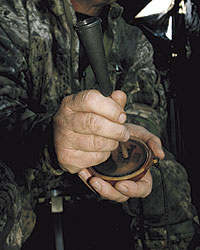 Carry a turkey call with you next time you venture into the deer woods. Subtle and social turkey calls can put nearby deer at ease. |
Bowhunting's about getting close, very close. Depending on circumstances this can prove surprisingly easy, but more often excruciatingly difficult. There are times and places when you'll swear it is flat-out impossible. The latter is typically borne of tackling problems with a stubborn, straight-ahead approach. You spy a bedded mule deer and stalk straight at him with the wind in your face of course.
You discover a bevy of feeding deer at a field's edge and naturally think hanging a stand and putting in your time will bring success. Successful bowhunting often demands more lateral thinking, studying a situation carefully and thinking several moves ahead. Unproductive bowhunting can also result from adhering to tired ploys game's already savvy to like bugling to elk or rattling for whitetail; guarding whitetail scrapes that are visited by bucks only under the cover of darkness. Sometimes it helps to step outside the box.
Advertisement
The Art Of Deception
This isn't a discussion on the latest camouflage sensation, but blending in on more subtle levels than the obviously visual, which wild animals depend on much less than we do. And no, this isn't another angle on the often-suspect business of scent control and "forget-the-wind" hyperbole. Unless you're "The Boy In The Bubble", arriving upwind of a whitetail deer, elk, or most especially black bear, assures that no matter what you're wearing, dosed in or have recently showered or sprayed down with, that animal will shortly detect you via an olfactory system nearly unfathomable in efficiency.
Sure, such products can provide temporary subterfuge that gives you a few extra seconds to get off a clean shot, or to make distant game believe you're farther away. But remain upwind within even bottom-pin range long enough to, say, wait for a buck to take one more step or turn just so, and you're busted.
Advertisement
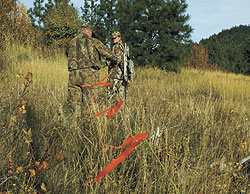 Whitetail deer, especially in farm country, are used to new developments in their habitat. Still, common sense dictates what type of barriers will gently deflect a deer past your stand and what will spook them onto the neighboring farm. |
I'm hinting at cues, often dismissed by hunters, that help game keep tabs on what is happening in their world like chattering squirrels, squawking jays, tattletale crows or ravens. Without confirmation that such alarms are part of the natural order a trophy buck may slip away without detection. At best, it may not command his immediate attention, but you've just become suspect in a world of potential trouble.
Non-Threatening Approaches
The trick is in making yourself appear neutral, at least to that deer listening 100 yards up the ridge. Quiet turkey talk is the easiest way to set nearby deer at ease in habitat where the birds are common, which today covers nearly anywhere in the country; especially whitetail country.
These aren't the raucous attraction yelps and cuts of spring seasons, but subtle, everyday social calls turkeys use to maintain ranks while traveling and feeding. Soft clucks, purrs and "do-weeps" (like a drop of water falling into a half-filled bucket) are what you are striving for. Such turkey talk doesn't carry far, perhaps 150 yards under ideal conditions, but provides confidence and adds realism to your movements through foreign habitat.
Another natural confidence call is the soft contact bleats young fawns produce when temporarily out of sight of their mothers. It is best described as a short blat, which is a short, single-syllabled call that doesn't carry far. If you've been paying attention and understood what you were hearing you've likely heard such vocalizations in deer woods.
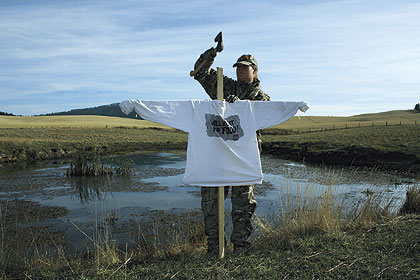 Bowhunting near water is a time-proven technique for earning close-range shots. When watering options are as abundant as game, a scarecrow can help eliminate options and deflect more animals to a waterhole of your choosing. |
Recently, on stand in my Idaho backyard, I witnessed these calming calls firsthand. Deer were just beginning to move that evening; a doe and fawn pair already munching wild apples directly beneath my stand. Soon another doe melted into view, a lone doe arriving for her share of fragrant fruit. She appeared to be alone.
But then I heard it, subtle but unmistakable, that quiet yet telltale bleat of a young deer. Junior had dawdled and temporarily misplaced "Mama". The little fellow bleated his way closer, a short call every three to five seconds, his mother completely unconcerned, going about business. Soon I could hear the bleating fawn's little hooves scampering noisily across dry leaves. The deer already beneath my stand never lifted their heads.
These are non-aggressive, commonplace calls game hear regularly. It might be likened to the background clutter of jetliner rumble well overhead or hissing traffic on a distant highway we ignore on a daily basis in our own urban surroundings. Yet, while game normally doesn't consider such noise a threat, it serves as deceit that can provide a free pass while stalking or still-hunting.
Uncommon Deceit
One of the most outrageous examples of saving the day through deceit occurred while guiding an elk hunter in New Mexico's Gila region. We'd dogged a behemoth bull most of the morning, following his receding bugles for miles. His calls had become less frequent and we were following on intuition alone. I rounded a ground-hugging cedar and came abruptly eye-to-eye with one very tense spike bull.
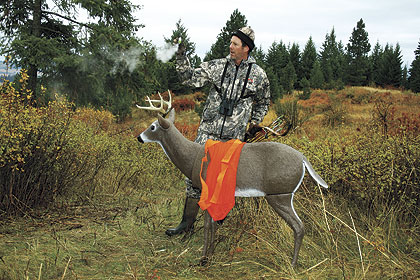 Deer decoys can bring big bucks on the run during the whitetail rut in areas with high buck-to-does ratios. In the more typical hunting areas where most of us hunt, deflection ploys will normally prove more productive; placing decoys well up-wind to intercept bucks swinging wide to scent-check your fake. |
He threa
tened to blow the entire show. With nothing to lose, and knowing cattle shared this pasture, I delivered my best cow impression "Moooooo!" Remarkably, the spike immediately calmed and went back to feeding. Now we had the new predicament of controlling our nearly uncontainable laughter. Minutes later my client received his shot at the herd bull we'd dogged so far, broadside at 39 yards, unfortunately his arrow flew a little too high, but the deceit had performed its magic.
Also keep such ploys in mind while accessing your favorite fall stand. On dead-still days it seems walking across the prerequisite blanket of leaves will alert every deer in the county. Remember your turkey diaphragm call, box call or even a squirrel call, leave a few minutes earlier than usual and "feed" to your stand. Pause occasionally to produce a few quiet turkey clucks/purrs or squirrel chatter; scratch in the leaves momentarily, taking your time, moving in natural stop-and-go fashion. Any deer within earshot becomes convinced you're a passing flock of turkeys or a foraging squirrel.
You might use a fawn bleat instead, though avoid standard-issue models producing attention-grabbing distress calls, bleating your way into stands like a fawn trying to keep up with Mama. Those difficult-to-access morning stands at field edges? Does that field hold milk or beef cows?
Welcomed Deflection
Archery deflection is normally thought of in terms of painful misses caused by branches sending well-directed arrows askew. In bowhunting deflection can also indicate positive connotations, deflection that pushes game past any fixed position. Variations and possibilities are restricted only by your imagination and willingness to address obvious problems with unorthodox approaches.
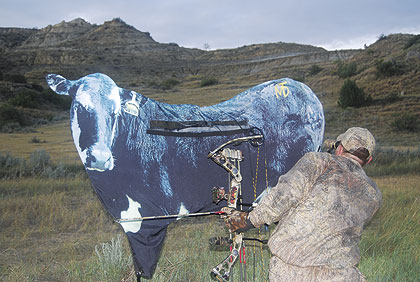 Offbeat ploys can pay huge dividends when chasing big game in the field. Montana Decoy's introduced their Moo Cow in 2008, which is perfect when trying to deceive wary animals coming into watering holes or when stalking in cattle-rich open country. |
Here's a perfect example: Imagine a long strip of river bottom, flanked on one side by railroad bed and high bluff supporting sprawling suburbia, to the other by a river substantial enough to invite freighter traffic. This bottomland cover's narrow, perhaps just wide enough to cover with a mid-point stand if you could only shoot through all that tangled cover. Downstream is a huge cornfield, upstream wildlife sanctuary. The deer are coming, sure as taxes. The problem's posed by wind spilling from those bluffs, across the cover and onto that river. To work the wind your stand must sit against the water. This opens at least half the bottom to unprotected passage.
This is the exact scenario I once faced on a Nebraska Missouri River property. There were big bucks to be had, but I didn't have time to wait for crapshoot odds. During a 20-hour marathon drive from New Mexico I'd worn a single shirt, now saturated with the smoke from cigars I'd used to stay awake and alert. There might have been some gas-station hotdog mustard and burrito juice dribbled down its front as well. The socks I'd worn inside worn-out boots smelled worse. So, naturally, I took them to the stand with me one morning.
I hung my laundry along an ancient fence at the edge of the railroad cinders, perhaps 100 yards toward the corn from my position (Being a morning hunt deer were traveling from food to bedding safety. With evening, when traffic flow reversed, I would shift the clothing upstream). I knew my rank clothing was doing the trick when I heard a doe snorting just after daylight.
The traffic beneath my stand increased noticeably during the next couple days. I wish I could drive my point home with a tale of big-buck success, but that wouldn't be true. The point is deer traffic did increase beneath my stand; from one or two does/small bucks a morning/evening, to five to 10. I was successfully deflecting, as near as I could tell, nearly every deer in that narrow cover past my stand instead of being privy to only a few.
A Gentle Nudge
Now apply what I learned in Nebraska to a favorite windrow stand, sharp ridgeline or your own strip of river bottom. Deflection might also apply to water-hole situations, addressing an area with plenty of game but too many options for thirsty animals.
Think of the average scenario presented by an expansive agricultural field, a Midwestern corn or bean field or one of western alfalfa, and the deer that arrive to feed with evening. While deer abound, ambush can prove dodgy. Increase your odds by decreasing options available to game. Of course, taken too far you run the risk of deflecting deer too well, like into the adjacent property or county, so applying a dose of common sense is highly important.
Too, dirty laundry might be replaced with something like mountain lion urine (found online at trapping-supply houses) in elk or mule deer country, especially near water holes. Home gardeners have long used human hair, gathered from local hair salons, to deter marauding deer from vegetable and flowerbeds. Sprinkled judiciously the same ploy can move deer toward your position or deflect them away from a place that does you no good.
 The author had a single day to hunt pronghorn on this Montana foray. Speed goats were abundant, but so were watering sources. The author used feed-sack flags and a hunting vehicle to spook antelope from surrounding watering sites and deflect this buck to his chosen water. |
Returning to water-holes scenarios, a scarecrow placed on water that doesn't invite a convincing blind or one too large to effectively guard with short-range archery gear can help deflect pronghorn or deer to one that does offer a chance of success.
Decoy Deflection
Most whitetail, even pronghorn or elk, hunters deploy decoys hoping to elicit direct approaches. In the right place (those with high buck-to-doe ratios), during the right time (the rut), this can certainly be the case but I wouldn't count on it. Using a big-game decoy in deflection ploys typically proves more effective. Most pointedly, the natural inclination of any wary, olfactory-driven animal is to swing downwind when encountering any curiosity.
Setting up on top or directly behind your decoy in hopes of luring game within range isn't nearly so productive as smartly placing your fake in relation to your position and wind to intercept animals "scent-checking" that decoy. This is easier to pull off than might first seem apparent, taking into account terrain, natural funnels and most especially wind direction. Some trial and error might be needed to determine the comfort zone of game in your area, namely how closely or distantly they'll swing below a deke. As a general rule, try 200 to 300 yards to begin.
Hemming 'Em In
When confronted by a regularly-productive ridge, tree-line, river bottom or even farm field that also presents uncertain ambush dilemmas, a little landscaping might just boost your odds of deer encounters this fall.
Most animals instinctively follow the path of least resistance when unmolested. Creating subtle funnels of cut brush, logs or other natural debris well ahead of season can turn an iffy stand site into a busy intersection. Leaving a farm gate open or creating a fence break (where possible and permissible) can also create such a funnel. When hunting around agricultural fields, creating paths between fields and through brush might be exactly what's in order to funnel deer past your ambush locations.
At home in Idaho I hack trails through thick, head-high alder and berry scrub, or even the tractor mower when terrain allows, to make it easy for deer to travel past my stands. Again, don't be afraid to think outside the box. For example, a "fence" of light rope festooned with surveying ribbon might do the trick in deflecting deer past your stand. A line of hanging, fluttering, twisting pie plates or soda cans might also prove effective.
Success in bowhunting often demands more than putting in more time; walking farther, hunting longer, venturing where few others will. This isn't an issue of employing the latest trick of the pros, some new wonder game call or magic-potion buck lure.
This is about hunting with brains instead of brawn, opening your mind to new ideas in an attempt to bend the whims of your quarry to your needs and time schedule. Deflection is all about making your prey believe you're something that you're not; something completely benign that helps you slip in close enough for a shot.
